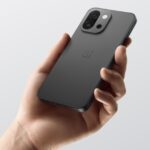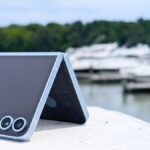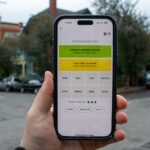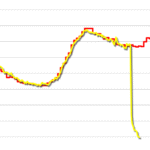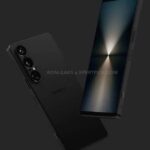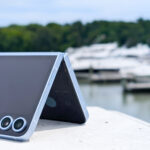After years of waiting, we finally know a whole lot more about the Nintendo Switch 2. In a Direct presentation on Wednesday morning, Nintendo revealed a host of highly requested features coming to its latest console, from 4K support to significantly expanded storage. Even with all of that clarity and detail, seeing — and playing — is believing with a new console. And after actually playing the Nintendo Switch 2, I’d say I’m a believer.
Following the showcase, I went hands on with Nintendo’s new console. I demoed several games, from Mario Kart World to Metroid Prime 4: Beyond, as well as third-party heavy hitters like Split Fiction and Cyberpunk 2077. From that wide range of demos, I was sold on the tech upgrade here, which brings the Switch 2 more in line with the Steam Deck.
The biggest surprise of all though? Nintendo’s new mouse feature isn’t just a Joy-con gimmick: It works way better than you’re expecting.
Console overview
The first time I picked up the Switch 2 to play Mario Kart World, I could already feel that Nintendo is going for a premium upgrade. The system is hefty and sleek compared to the original Switch, feeling more like a pricey piece of tech than a brightly colored toy. For instance, its kickstand is a significant improvement over the small plastic nub on base model Switches. It’s sturdy and able to bend so far that the console can nearly lay flat in tabletop mode.
That serious engineering can also be felt in the new and improved Joy-con controllers. If you’re worried that the controllers hold on to the console magnetically, don’t be. Once popped on, which can be done with virtually no effort, they don’t so much as wiggle in place. It doesn’t feel like a child could yank them out, though never underestimate the destructive power of a kid. On the flip side, they pop off just as easily when I press down the release button at the top of each Joy-con. Naturally, I’ll need to see how they hold up to wear and tear over time, but it seems like Nintendo is taking its engineering seriously here.
In terms of comfort, not much is different between the original Switch and Switch 2. Yes, the latter is noticeably larger, but they don’t feel too far off in weight when I hold my Nintendo Switch OLED and the Switch 2 in each hand. The main difference, again, is that it feels more like I’m holding a powerful Apple tablet instead of a Nintendo handheld. It’s subtle, but it adds up when placed next to tweaks like larger joysticks.
There’s one caveat to all this: There are still some big questions to answer and Nintendo isn’t being entirely forthcoming about them all. During the demo event, attended by press and content creators, Nintendo hosted a roundtable Q&A with members of the Switch 2 development team. While the team confirmed features like ray-tracing and eshop improvements, it almost entirely dodged questions about Joy-con stick drift, battery life, and details on the custom Nvidia chip being used in the system. Those moments left me with some trepidation, as it sounds like a few of the Switch’s pain points may be left unsolved.
Definitely an tech upgrade
That premium feel isn’t just for show. The Switch 2 is significantly more powerful than its predecessor, and that was proven to me several times throughout my demo time. My first real shock came when I played Metroid Prime 4: Beyond, which I later heard was running at 120 frames per second at 1080p resolution, though I can’t fully confirm that. For a game that was built for the original Switch first, it looked and felt incredible. Detailed environments full of action and an ultra smooth framerate gave the prime series’ historically stellar art direction the boost it needed to take it to the next level.
The upgrade is also noticeable in Nintendo Switch 2 Editions of original Switch games. The Legend of Zelda: Tears of the Kingdom looks remarkable on the new handheld, making the LCD display look every bit as good as an OLED screen. Its improved framerate was almost surreal to witness after playing it for 100 hours on Switch; it’s like you’re watching a YouTube video of someone jailbreaking it on PC and unlocking its framerate. After decades of lagging behind, it feels like Nintendo has finally caught up to its peers on performance.

Actual visual fidelity is a little harder to judge. Nintendo often deals in cartoon art styles that have a ceiling compared to hyper-realistic games. Mario Kart World sure looks pretty with its vibrant colors, but I can’t say that it feels like an enormous step over Mario Kart 8 Deluxe, even if it is. Other first-party games, like Drag and Drive, still feel like they could run on the original Switch with their visual fuzz.
Ultimately, it’ll be up to third-party developers to show us just how far the hardware can go, and I did get a taste of that too. I played (and watched others play) several third-party games through the demo event, and was impressed to varying degrees. Street Fighter 6 looks as good as it does on other consoles at a distance, while Hades 2 wowed me with its high and smooth framerate. Don’t expect PS5 levels of performance, though. Cyberpunk 2077 looks and runs not too far off from how it does on Steam Deck, with some jagged visuals and 30fps on quality mode (a representative from CD Projekt Red at the event tells me that the studio is targeting around 40 or 45fps on performance mode). Split Fiction is in a similar position, with its glitzy next-gen sheen compacted a bit into crunchier visuals. It was noticeable on a big TV, but I’m eager to see how it all translates to handheld mode. I imagine games like Cyberpunk will feel significantly more impressive in that context.
The good news for Nintendo is that developers have seemingly found the process of getting games running on Switch 2 easy compared to Switch. A Hazelight representative I spoke to at the event noted that It Takes Two’s Switch port required a lot of reworking to get it running right. Split Fiction didn’t need any such tuning, and adapted to the new device naturally. I heard similar thoughts from CD Projekt Red and Firaxis, who all called out how smooth the transition has been. That’s hopefully a strong sign for the console’s long-term health when it comes to power, as developers seemingly won’t have to work as hard just to get a game running on the hardware at all.
Mouse-cons are the real deal
Those tech advancements are impressive, but the real test of my demo was the console’s experimental new feature: its mouse-like Joy-cons. Ever since they were announced, I’ve been a vocal skeptic about them, assuming that they’d be a weird Nintendo gimmick that gets abandoned after a year of tech demos. After using them, I’ve completely changed my tune. The “mouse-cons” are the real deal and could be a legitimate ace in the hole for Nintendo if developers actually utilize them.
My impressions got off to a questionable start when I demoed Drag and Drive, Nintendo’s wheelchair basketball game. The idea is that players control each of their wheels by dragging their controllers over a table. The tutorial taught me how to drive forward by pushing both controllers across the table and turn by slightly pressing only one forward. I couldn’t get the hang of it initially and could barely drive in a straight line. That was only a tutorial problem, as it turned out. You don’t drive for long stretches in the actual game, but rather navigate a small basketball arena during a three-on-three round. I took to the mouse controls much quicker here, as I was directing myself into the ball or my opponents with ease thanks to shorter movement spurts. It was a fun start, but not enough to change my mind about the feature’s long-term fate.
Then I played Metroid Prime 4: Beyond.
Without a doubt, this was the most impressive experience I had during the entire day. With my right Joy-con flat on a table, I could aim Samus’ arm cannon the same way I would with a Wiimote in Metroid Prime 3: Corruption. My other hand was free to hold the left Joy-con naturally and move with a joystick. To my shock, the control scheme worked beyond my expectations. My aiming was incredibly precise, as if I really was using a mouse. That’s partially thanks to the fact that the controllers glide across a surface with no hiccups. I was able to quickly take out a room full of space pirates with ease, sending missiles exactly where I wanted them to go with no error. Even if I were to run into trouble, I could pick up the right Joy-con at any time and switch over to traditional gamepad controls without going into a menu to change the settings. It was the kind of video game magic trick that only Nintendo delivers this well.

That precision held up in other games I demoed too. I tried several mouse minigames in the Nintendo Switch 2 Edition of Super Mario Party Jamboree and each one felt natural and intuitive. In one, I had to drag my controller back to wind up a toy car and send it flying into a goal across the screen. I felt like I could place it exactly where I wanted it to end up based on how far I pulled back. In Nintendo Switch 2 Welcome Tour, I tried a simple minigame where I dodged falling spike balls by piloting a ship like a cursor. Again, there was no discrepancy between my actions and my ship’s movement on screen. I smashed the gold medal record for the game by a good 20 seconds on my first try, no adjustment or learning curve needed. Civilization 7 felt especially right for the system, as I could control the action on screen much more precisely than I can on the Steam Deck’s trackpad.
There were two things I hadn’t considered when I talked smack on the idea originally. One is that the mouse functionality pairs with gyroscope tech, which creates unique gameplay experiences. In Drag and Drive, for instance, I could lift my right hand off the table to shoot a basket and then place it back down to keep driving. What’s even more unique about the feature is the fact that players can use two mice simultaneously. Again, Drag and Drive is the shining example of the possibilities. Being able to control two wheels with separate mice sets it apart from any motion or mouse controlled game I’ve ever played. If developers can invent new ways to take advantage of those ideas, Nintendo could have something special here.
But let’s be realistic. Nintendo has a long history of creating great ideas that are a hassle to develop for. The Wii U’s two-screen experience, the 3DS’ 3D, the Switch’s IR sensors — all of these were flash in the pan ideas. I still don’t believe that many developers will put their all into making full on two-mouse games with gyroscope integration. I don’t even believe that Nintendo will do it outside of a few launch year games. I didn’t see the feature on display in Mario Kart World or Donkey Kong Bananza. I just see history repeating itself here, with flagship games skirting around a feature that’s relegated to a multiplayer gimmick.
Third-party developers do seem eager to try, though. Cyberpunk 2077 will support mouse aiming and will even feature motion controls that let players mimic actions like healing. I imagine you’ll see the mouse-con mostly used in shooters and strategy games, which feel like the best use cases for them. Nintendo Switch 2 feels like the only console choice for Civilization 7, and I think that will hold true for games like it if developers follow suit.
There’s only one hitch to the feature: It’s not entirely comfortable. The Joy-cons were never designed to be held like this, so it doesn’t feel totally right to palm around a thin piece of plastic rather than a form-fitting shell. It worked well enough in 15 minute demo chunks, but it’s hard to imagine playing Call of Duty like that for three hours straight. Maybe I’ll be proven wrong again, but it feels like Nintendo is leaving an opportunity for third-party manufacturers like Dbrand to put out must-own controller shells.
My experience with the Switch 2 was wide-ranging, taking me through several games over hours of demos. I tried it in handheld mode, I experienced games on 4K TVs, and I played plenty of mouse experiences with a big table in front of me. The system impressed me in all of those use cases, making an already great console feel even better. That’s not to say it’s perfect. I’ve already found things to nitpick and I’m sure to be more critical about battery problems or stick drift on a $450 console. This is a big investment compared to the Switch, bringing it in line with future-proofed systems like the PS5. I don’t know that I’ll be as kind to the quirks this time if I’m paying top dollar to live with them for eight years. But from what I’ve seen, the system is much more up to speed with its peers than I could have possibly imagined. It really feels like Nintendo’s first true “next-gen” console, and I’m ready for the ride.
Read the full article here


